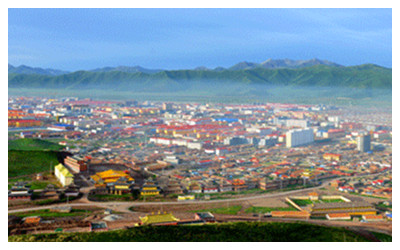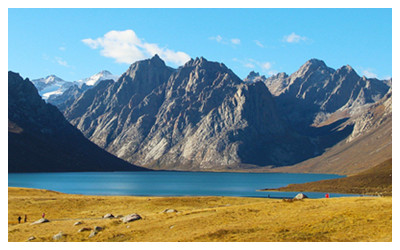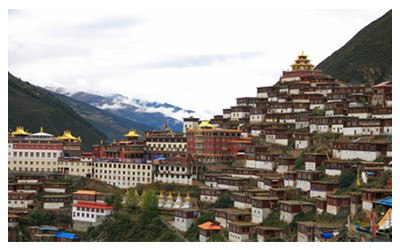Skype: neodalle-travel
Tel: +86 135 7447 2266
E-mail: sales@visitaroundchina.com
 Located in the southeast region of Qinghai Province, Golog Tibetan Autonomous Prefecture neighbors Gansu on the east and Sichuan on the south. Its neighbors within the province include Yushu Prefecture to the west and by Haixi, Hainan and Huangnan prefectures to the north.
Located in the southeast region of Qinghai Province, Golog Tibetan Autonomous Prefecture neighbors Gansu on the east and Sichuan on the south. Its neighbors within the province include Yushu Prefecture to the west and by Haixi, Hainan and Huangnan prefectures to the north.Facts of Golog
Full Name: Golog Tibetan Autonomous Prefecture
Chinese Name: 果洛藏族自治州 (guǒ luò zàng zú zì zhì zhōu)
Location: in the southeast region of Qinghai Province
Area: 76,312 square kilometers (29,464 square miles)
Population: 149,800
Nationalities: Tibetan
Administrative Divisions: 6 counties: Maqin (Maqen), Banma (Baima), Gande (Gade), Dari (Darlag), Jiuzhi (Jigzhi), Maduo (Madoi)
Seat of the Prefecture Government: Dawu Town, Maqin County
History of Golog
It was inhabited by Dangxiang (an ancient tribe in northwest China), a branch of the Qiang minority, one of the oldest tribes in China. Until 1946 Guoluo was led by the heads of more than two hundred tribes. Guoluo District was established directly under Qinghai Province in 1950. In 1954 the Guoluo Tibetan Autonomous Prefecture was established.
What to see in Golog?
Golog prefecture has a vast expanse of territory, occupying more than one tenth of Qinghai's total land area. There are rivers and mountain ranges crisscrossing the region and alpine lakes inlaid among them. The terrain basically declines from the northwest to the southeast. The terrain of the somewhat higher northwestern region slopes gently, while the slightly lower southeastern region boasts many high mountains and deep valleys. Here lists top attractions in Golog.
 |
 |
 |
| Nianbaoyuze Scenic Area | Bayankala Mountain | Golog Baiyu Monastery |
Golog is the hinterlands of the Qinghai-Tibetan Plateau. The Bayan Har (Bayankala) Mountains, Kekexili Mountains, Anyemaqen Mountains and Tangula Mountains zigzag through southern Qinghai, giving birth to three of the world's great rivers: the Yangtze, Yellow and Lancang Rivers.
Anyemaqen Mountains: The main peak of the Anyemaqen Mountains is Mt. Anyemaqen, being one of China's ten peaks open to foreign climbers. Gyaring (Zhaling) Lake and Ngoring (Eling) Lake are sister lakes, comprising the largest bodies of fresh water in the Yellow River basin. Around these two pools of liquid sapphire, are the hunting areas of the Huangheyuan International Hunting Ground.
Baima County: It is a green town with moderate climate and elegant natural scenery. Canyons, virgin forests and blockhouse style houses (Diaolou Building) and Buddhist temple buildings make this beautiful county a hot tourist destination.
When to visit Golog?
The place enjoys a continental plateau climate, characterized by high altitude, cold weather, thin air, strong ultraviolet radiation and great temperature variation between day and night. It only has obvious cold and warm seasons. The cold season of Guoluo weather begins from October with an average temperature during the coldest month of -12.1℃ (10.2℉). Starting in June, the warm season lasts only three or four months, during which the weather is moderate with the warmest average monthly temperature being about 9℃ (48.2℉). The warm season (June to October) is the most favorable period to visit Guoluo, weather-wise. Tourists who love mountain climbing should go to holy Mt. Anyemaqen during late April to June or September to October.
How to reach Golog?
Guoluo Maqin Airport is located in Dawu Town, Maqin County, Guoluo Tibetan Autonomous Prefecture, Qinghai Province, China, 7.5 kilometers away from the county town of Maqin County. On July 1, 2016, Guoluomaqin Airport was officially opened to traffic.
Xining is about 440 kilometers from Dawu Town, the seat of local's prefectural government. Visitors can take a bus from long-distance bus station, located on Jianguo Road in Xining along the Xining-Jiuzhi Highway. This is also the route to Golok Mountain for climbing.
The bus station in Dawu Town is located on Tuanjie Road and has daily buses to Xining and Chengdu.
Golog Travel Tips
1. Local Highlights: Tibetans make up nearly ninety-one percent of the total population of Guoluo Prefecture, a pastoral area with strong Tibetan flavor.
2. Special Local Products: Tibetan herbs, such as Chinese caterpillar fungus; Ginseng Fruit (Potentilla anserina), Chang, Yak jerky, crab apples, black lamb skins.
3. China Post: Tuanjie Road, Dawu Town, Maqin County
4. Useful Telephone Numbers:
Tourist Complaints: 0975-8383842
Weather Forecast: 121
Zip Code Inquiry: 184
 Ask Questions ?
Ask Questions ?